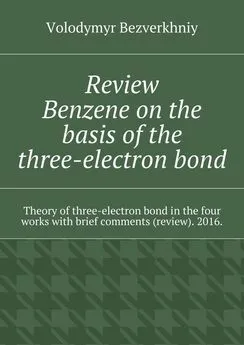Anatoly Kondratenko - Probabilistic Theory of Stock Exchanges
- Название:Probabilistic Theory of Stock Exchanges
- Автор:
- Жанр:
- Издательство:неизвестно
- Год:2022
- ISBN:нет данных
- Рейтинг:
- Избранное:Добавить в избранное
-
Отзывы:
-
Ваша оценка:
Anatoly Kondratenko - Probabilistic Theory of Stock Exchanges краткое содержание
Probabilistic Theory of Stock Exchanges - читать онлайн бесплатно ознакомительный отрывок
Интервал:
Закладка:
We emphasize that for the purposes of this study we made no difference between stock, commodity, currency and other exchanges; the theory developed is equally suitable for describing any exchange where assets are traded, so for brevity in this book we will talk about stock exchanges, or simply exchanges.
As a conclusion, we provide a summary of the monograph with a subjective evaluation of the results obtained and the conclusions drawn in the study. The book outlines the basics of the probabilistic theory of stock exchanges, built on the basis of probabilistic economic theory using agent quotations provided by stock exchanges. By its nature, this theory of exchanges is microscopic, so its analytical and numerical methods make it possible to calculate and describe various exchange microstructures and microprocesses. The calculations of this type were performed for the first time in this study and are also published for the first time. The main attention was paid to the calculation of market prices and trade volumes of various assets (Sberbank shares, Brent oil futures, American dollars) on the Moscow Exchange and Intercontinental Exchange Futures Europe (Brent oil futures) during one trading session, as well as a detailed comparison of the calculation results with the experimental data. This comparison demonstrates a good agreement between theory and experiment, which allows us to state that the monograph has fulfilled the main scientific purpose of the proposed study, namely, to show that the probabilistic economic theory finds experimental confirmation and, thus, acquires solid experimental justification.
This sets it apart from other economic theories of a heuristic or empirical nature. Another important purpose has also been fulfilled, namely to describe in detail the economic mechanism underlying the formation of market prices and trade volumes and serving as a bridge connecting the microscopic and the macroscopic economic world, thus demonstrating the process of macrocosm formation from microcosm, namely how the actions of exchange agents form the action and temporal dynamics of the market as a whole.
A new, universal system of exchange indices of assets, stock exchanges and the global system of exchanges has been developed. By analogy, the strategy of digitalization, forecasting and management of economies on the basis of digital platforms was developed for accumulating plans of economic agents and processing them using the formulas of probabilistic economic theory, which, if implemented, will in turn improve the quality of public administration of the economy of individual countries and the world as a whole.
The monograph demonstrates the importance and significance of stock exchanges as experimental economic laboratories, aimed primarily at testing models, evaluating parameters of models and, ultimately, verifying the existing and new economic theories. While the construction of probabilistic economic theory as an «empirical» laboratory was to a certain extent backed up by the business, the practical 25-year experience of management of which was formalized by the mathematical body of theoretical physics, the development of probabilistic theory of stock exchanges in the study was based on MOEX and ICE as experimental economic laboratories. Step by step, the monograph reveals the enormous prospects for the further use of stock exchanges as powerful up-to-date experimental economic laboratories, which allow us to argue that just as theoretical physics emerged from the science of the solar system some 300–500 years ago, in the near future a modern economic science, consisting of closely interacting theoretical economics and experimental economics, will emerge from the development of stock exchange theory based on exchange experiments that will match all generally accepted standards for physical sciences, while remaining a human and social science.
Acknowledgments
The content of the book is a summary of the results of the project "Quantum Finance Investments of EXCELLENCE Investment Company" in Novosibirsk.
Project participants Vitaly Martynovich and Maria Makarkina contributed greatly to the project's success. Thus, the computer platform QUANTUM FINANCE for calculations of exchange structures using the probabilistic economic theory methods was developed by Vitaliy Martynovich and Maria Makarkina and implemented in C#. Maria Makarkina also provided substantial assistance in preparing this monograph for publication. The author sincerely thanks them for the fruitful cooperation for many years.
The author considers it his duty to thank Dmitry Sviridenko, who undertook the important work of the responsible editor of the monograph, and the reviewers of the monograph, Sergey Parinov and Yuri Perevyshin, for the challenging work of reviewing the manuscript with the new theory at a high professional level.
The author is grateful to the Alexander von Humboldt Foundation (Alexander von Humboldt – Stiftung), which provided a scholarship that enabled the author many years ago to witness for the first time how developed market economies work and how financial markets function in West Germany.
The author is grateful to Moscow Exchange and Intercontinental Exchange Futures Europe for providing access to historical data and online quotations.
The author is also grateful to the investment companies FINAM and Interactive Brokers for their excellent broker-intermediary functions with the IB and ICE exchanges, respectively.
The author sincerely thanks the first reader of the book manuscript, Konstantin Gluschenko, for critical comments, consideration of which made the material of the book more understandable for readers who hold fundamentally different orthodox economic views.
In conclusion, the author would like to take the opportunity, unfortunately, very late, to pay back some of his old debts.
First, the author would like to thank Vladimir Evstigneev for his informal but very informative and useful review of the author’s first paper on probabilistic economic theory in the collection of papers of the Russian Academy of Sciences and State Administration [Kondratenko, 2005] and Ksenia Kondratenko for her help in preparing the manuscript of this paper. Second, the author notes the important role that Professor George Judge of the University of California (Berkeley) played in this research by approving and enthusiastically supporting that very first paper 15 years ago, for which the author is immensely grateful.
Editor-in-chief
DSc in Physics and Mathematics Professor D.I. Sviridenko
Reviewers:
DSc S.I. Parinov
PhD Y.N. Perevyshin
All rights reserved. No part of the book or whole book may be reproduced or transmitted in any form or by any means without the written permission of the author.
FREQUENTLY USED SYMBOLS
Г – agent width
MOEX – Moscow Exchange
BRENT – Brent oil futures
C – normalization factors
D – demand
D ( t, p, q ) – probabilistic market demand function
D 0( t ) – total market demand function
ICE – Intercontinental Exchange Futures Europe
F ( t, p, q ) – probabilistic market deal function
M ( t )– number of supply quotations
N ( t ) – number of demand quotations
MTV ( t ) – probabilistic market trade volume
P – price
p – independent price variable
p M – probabilistic market price
q – independent quantity variable
q M – probabilistic market quantity
Q – quantity
PQ – price and quantity
S – supply
SBER – Sberbank shares
S D – supply and demand
S ( t, p, q ) – probabilistic market supply function
S 0 ( t ) – total market supply function
t – independent time variable
TV ( t ) – trade volume
T – time
USD/RUB – USD/RUB futures at MOEX: U.S. dollars are traded for Russian rubles (₽).
INTRODUCTION
"The impartial observer can have no doubt about the reason our generation pays general and enthusiastic tribute to progress in the field of the natural Sciences, while economic Science receives little attention and its value is seriously questioned by the very men in society to whom it should provide a guide for practical action. Never was there an age that placed economic interests higher than does our own. Never was the need of a scientific foundation for economic affairs felt more generally or more acutely. And never was the ability of practical men to utilize the achievements of Science, in all fields of human activity, greater than in our day. If practical men, therefore, rely wholly on their own experience, and disregard our Science in its present state of development, it cannot be due to a lack of serious interest or ability on their part. Nor can their disregard be the result of a haughty rejection of the deeper insight a true Science would give into the circumstances and relationships determining the outcome of their activity. The cause of such remarkable indifference must not be sought elsewhere than in the present state of our Science itself, in the sterility of all past endeavors to find its empirical foundations. The reason for this conspicuous indifference is none other than the present state of science itself, the fruitlessness of hitherto attempts to comprehend its empirical foundations".
Carl Menger [2007].
"Next, the empirical background of economic science is definitely inadequate. Our knowledge of the relevant facts of economics is incomparably smaller than that commanded in physics at the time when the mathematization of that subject was achieved. Indeed, the decisive break which came in physics in the seventeenth century, specifically in the field of mechanics, was possible only because of previous developments in astronomy. It was backed by several millennia of systematic, scientific, astronomical observation, culminating in an observer of unparalleled caliber, Tycho de Brahe. Nothing of this sort has occurred in economic science. It would have been absurd in physics to expect Kepler and Newton without Tycho, – and there is no reason to hope for an easier development in economics".
John Von Neumann and Oskar Morgenstern [1970]
The founding fathers of the Austrian school of economics established economic theory on a solid empirical footing in their day, which predetermined its successful development for many years to come. But the current levels of rigor of the underlying concepts and assumptions of these theories, as well as the quantitative description of real economic processes and phenomena, not to mention the quality of economic forecasts, are clearly insufficient for developing an evidence-based management of countries’ economies and achieving sustainable development of the global economy. There is a huge gap between the modern requirements that the society in its wide understanding presents to the economic science and the ability of this science to meet such requirements. This, as 150 years ago, generates a negative, at best ironic, public attitude to economic science, existing in the form of a number of often mutually exclusive theories, such as neoclassical economics and the Austrian school of economics (below often just Austrian economics), whose adherents give contradictory estimates, forecasts and recommendations. It has now come to the realization that empirical foundations alone are clearly insufficient for the verification of adequate models and approaches to economics. It is time to make a strict selection among all existing theories and currents of economic thought by means of their experimental verification in order to further develop economic theory, capable of providing a quantitative description of economic processes and phenomena at a high scientific level, comparable with the level of research in the natural sciences. As a result of this selection, economic theory will get a solid experimental foundation and become a unified economic science, like physics and other natural sciences, rather than a stream of ten parallel currents competing for financial resources, represented by neoclassical economics, Keynesianism, Marxism, etc.
Читать дальшеИнтервал:
Закладка:










